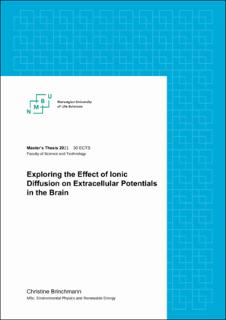| dc.description.abstract | Ionic concentration gradients can exist in the extracellular space (ECS) due to neuronal activity that can change the local ionic composition. Diffusion and electrical drift are two processes that move ions around in the extracellular space. These processes can be described by the Nernst-Planck equation. Ions diffuse along concentration gradients. Since ions carry charge, this process can give rise to electric currents, which, in turn, can result in a diffusion potential.
The question under investigation is if diffusion potentials in ECS are large enough to affect the measurements of local field potentials (LFPs) in the brain? Diffusion potentials are slow-changing potentials, so its possible contributions to the LFPs would be for low frequencies [1]. To explore the effect of diffusion potentials, I compared power spectrum densities (PSDs) of diffusion potentials to PSDs of LFPs recordings.
I estimated the diffusion potentials from extracellular concentration data collected from various articles. The concentration data were obtained from different experiments. Instead of numerically simulating how the diffusion potential changed, I approximated the diffusion potential by an exponentially decaying function. For more realistic estimates, I used time constants from temporal concentration data. Then, I estimated the PSDs of the diffusion potentials from each data set.
For LFP data, I found and used data files with LFP recordings. For these data files, I calculated average PSDs. In addition, I collected LFP data represented as PSDs from figures in articles,
At low frequencies (< 1 Hz), I found that PSD of the highest diffusion potentials had similar powers as the lowest PSDs of LFP measurements. Therefore, there may be a slight possibility that diffusion potentials can contribute to the LFP at the lowest frequencies.
I also estimated diffusion potentials at pathological conditions, such as spreading depression (SD), where concentration gradients are extremely large. I used the same approach and found that the diffusion potentials in these cases could be up to 10 times larger. The PSDs of the pathological diffusion potentials had similar powers as the LFP recordings. | en_US |

